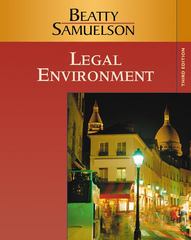Question
(1) Does the elasticity of demand or supply affect the burden of tax shared between the buyer and seller? A. Sometimes there is an effect,
(1) Does the elasticity of demand or supply affect the burden of tax shared between the buyer and seller?
A. Sometimes there is an effect, but most of the times there's only insignificant impact.
B. Yes. The elasticity of demand or supply has an effect to the burden of tax.
C. It depends on the type of market.
D. It cannot be determined.
E. No. There is no effect at all.
(2) Who suffers more given a tax imposition if the demand is more elastic than supply?
A. Both are not affected.
B. The sellers are affected more.
C. Both buyers and sellers are affected equally.
D. The buyers are affected more.
E. Cannot be determined.
(3) Is the minimum wage below wage equilibrium (w*) a binding price control? Why? Or why not?
A. Yes. The people will deal with the minimum wage law as implemented since it is lower than the market wage as price.
B. No. It is not binding because it is supposed to be a price ceiling.
C. Cannot be determined unless more information is provided.
D. No. It is not binding because the people in the market will deal in the market price equilibrium and hence will not go below that wage price.
E. Yes. The government will go after those who will not follow the law.
(4) When tax is imposed to a certain good, what is true about the tax incidence of it?
A. The total surplus increases as the government gets more revenue.
B. The tax incidence will only be shouldered by the buyers.
C. It does not depend on whether the tax is imposed on buyers or sellers.
D. The tax incidence will only be shouldered by the sellers.
E. The sellers usually suffer more than the buyers.
(5) Given the following equations for Supply (Qs) and Demand (Qd), and that the market is competetive, find the Pb (price of buyer) and Ps (price of seller), and the quantity demanded and supplied (Q*). Also, solve for the market price when there is no tax:
Supply equation: Qs= 50 + 4Ps
Demand equation: Qd= 80 - 2Pb
A tax of Php 3 (philippine peso) per unit was mandated by the government. Equation for tax (t) is:
t= Pb - Ps
For your answer, indicate in the 4 (four) blanks below the Pb, Ps, Q*, and the market price without tax in order or respectively. The first blank should be for the Pb, the second blank should be for the Ps, the third blank should be for the Q*, and the last blank should be for the market price without tax.
"Pb is __________, Ps is __________, Q* is __________, and Market price (P*) is __________"
(6) How much is the government tax revenue/collection based on the Php 3 tax imposition? (This question is a follow-up question based on the previous question no. 5)
Hi!! Please help? :( I need the answers in 2 hours if you can answer it asap? By the way, it's fine if you can't answer Question 6. Thank you so much.
Step by Step Solution
There are 3 Steps involved in it
Step: 1

Get Instant Access to Expert-Tailored Solutions
See step-by-step solutions with expert insights and AI powered tools for academic success
Step: 2

Step: 3

Ace Your Homework with AI
Get the answers you need in no time with our AI-driven, step-by-step assistance
Get Started


